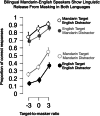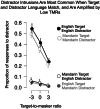A one-man bilingual cocktail party: linguistic and non-linguistic effects on bilinguals' speech recognition in Mandarin and English
- PMID: 38834918
- PMCID: PMC11150345
- DOI: 10.1186/s41235-024-00562-w
A one-man bilingual cocktail party: linguistic and non-linguistic effects on bilinguals' speech recognition in Mandarin and English
Abstract
Multilingual speakers can find speech recognition in everyday environments like restaurants and open-plan offices particularly challenging. In a world where speaking multiple languages is increasingly common, effective clinical and educational interventions will require a better understanding of how factors like multilingual contexts and listeners' language proficiency interact with adverse listening environments. For example, word and phrase recognition is facilitated when competing voices speak different languages. Is this due to a "release from masking" from lower-level acoustic differences between languages and talkers, or higher-level cognitive and linguistic factors? To address this question, we created a "one-man bilingual cocktail party" selective attention task using English and Mandarin speech from one bilingual talker to reduce low-level acoustic cues. In Experiment 1, 58 listeners more accurately recognized English targets when distracting speech was Mandarin compared to English. Bilingual Mandarin-English listeners experienced significantly more interference and intrusions from the Mandarin distractor than did English listeners, exacerbated by challenging target-to-masker ratios. In Experiment 2, 29 Mandarin-English bilingual listeners exhibited linguistic release from masking in both languages. Bilinguals experienced greater release from masking when attending to English, confirming an influence of linguistic knowledge on the "cocktail party" paradigm that is separate from primarily energetic masking effects. Effects of higher-order language processing and expertise emerge only in the most demanding target-to-masker contexts. The "one-man bilingual cocktail party" establishes a useful tool for future investigations and characterization of communication challenges in the large and growing worldwide community of Mandarin-English bilinguals.
Keywords: Bilingual; Coordinate response measure; Informational masking; Selective attention; Speech recognition.
© 2024. The Author(s).
Conflict of interest statement
The authors declare that there is no conflict of interest.
Figures





Similar articles
-
Listening Effort by Native and Nonnative Listeners Due to Noise, Reverberation, and Talker Foreign Accent During English Speech Perception.J Speech Lang Hear Res. 2019 Apr 15;62(4):1068-1081. doi: 10.1044/2018_JSLHR-H-17-0423. J Speech Lang Hear Res. 2019. PMID: 30986135
-
Effects of Language History on Sentence Recognition in Noise or Two-Talker Speech: Monolingual, Early Bilingual, and Late Bilingual Speakers of English.Am J Audiol. 2019 Dec 16;28(4):935-946. doi: 10.1044/2019_AJA-18-0194. Epub 2019 Nov 7. Am J Audiol. 2019. PMID: 31697566 Free PMC article.
-
Reception thresholds for sentences in quiet and noise for monolingual English and bilingual Mandarin-English listeners.J Am Acad Audiol. 2010 Apr;21(4):239-48. doi: 10.3766/jaaa.21.4.3. J Am Acad Audiol. 2010. PMID: 20388450
-
Speech perception in noise: Masking and unmasking.J Otol. 2021 Apr;16(2):109-119. doi: 10.1016/j.joto.2020.12.001. Epub 2020 Dec 11. J Otol. 2021. PMID: 33777124 Free PMC article. Review.
-
The cocktail party problem: what is it? How can it be solved? And why should animal behaviorists study it?J Comp Psychol. 2008 Aug;122(3):235-51. doi: 10.1037/0735-7036.122.3.235. J Comp Psychol. 2008. PMID: 18729652 Free PMC article. Review.
Cited by
-
Informational masking influences segmental and suprasegmental speech categorization.Psychon Bull Rev. 2024 Apr;31(2):686-696. doi: 10.3758/s13423-023-02364-5. Epub 2023 Sep 1. Psychon Bull Rev. 2024. PMID: 37658222 Free PMC article.
References
-
- Boersma, P., & Weenink, D. (2021). Praat: doing phonetics by computer [Computer program]. Version 6.1.38, retrieved 2 January 2021 from http://www.praat.org/.
-
- Bradlow, A.R., Ackerman, L., Burchfield, L.A., Hesterberg, L., Luque, J., & Mok, K. (2011) Language- and talker-dependent variation in global features of native and non-native speech. Proceedings of the International Congress of Phonetic Sciences. International Congress of Phonetic Sciences, 356–359. - PMC - PubMed
MeSH terms
Grants and funding
LinkOut - more resources
Full Text Sources
